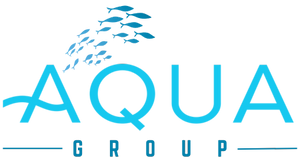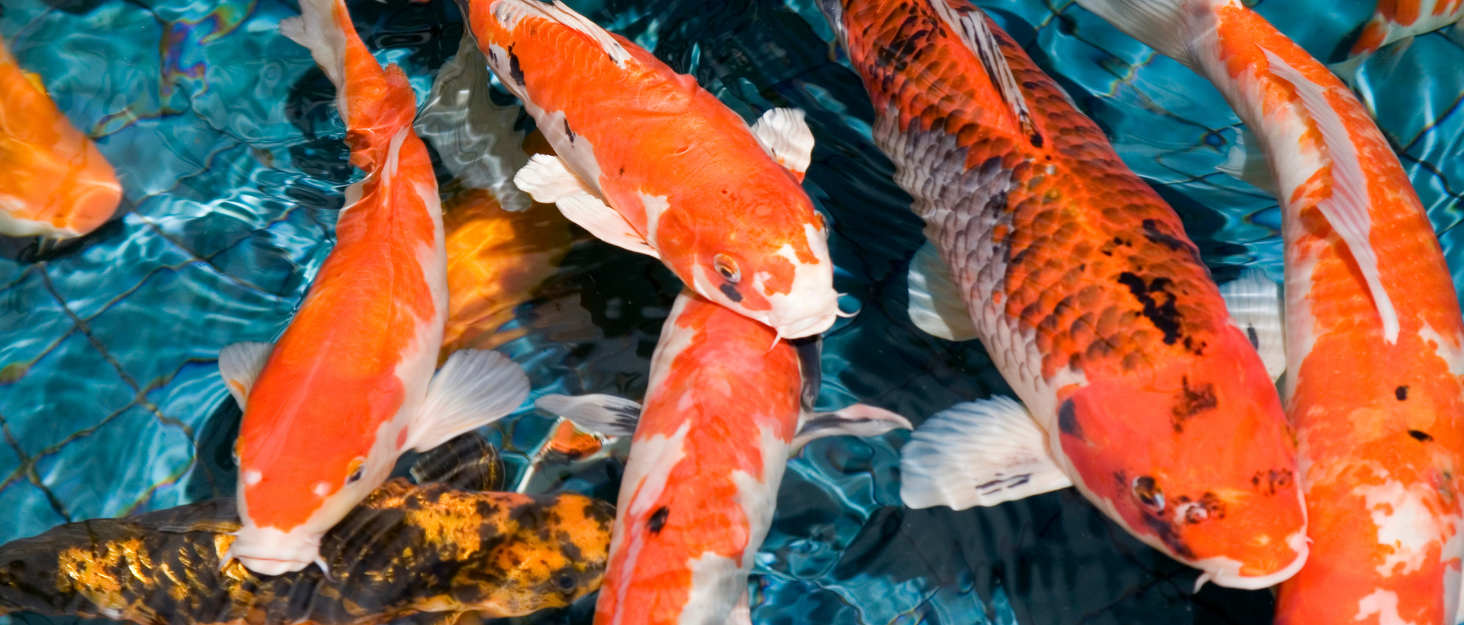Your koi are not just ornamental fish, they’re living works of art. But even the most beautiful koi are vulnerable to disease if your pond conditions aren’t optimal. In this guide, we’ll explain the most common koi health problems, how to spot them early, and what you can do to treat them safely and effectively. By arming your readers with this knowledge, Aqua Group can build trust and help them feel empowered to manage koi health.
Why Koi Get Sick: The Underlying Causes
Before diving into individual diseases, it’s crucial to understand the root factors that predispose koi to illness. Addressing these first improves every other treatment.
-
Poor water quality & imbalance
Elevated ammonia, nitrite, or nitrate levels, sudden swings in pH, low oxygen or poor circulation, all these stress koi and weaken their immune systems. Many disease outbreaks begin with water chemistry issues.
-
Stress & environmental change
Introducing new fish, sudden temperature fluctuations, overcrowding, or poor filtration can all stress koi. Stress is often the tipping point that allows parasites or bacteria to take hold.
-
Parasite, bacterial, fungal, or viral pathogens
Once stress opens the door, opportunistic organisms exploit weak fish. Parasites attach to gills or skin, bacteria invade wounds, fungi colonise damaged tissue, and viruses (in rare cases) may progress rapidly.
-
Secondary infection & chain reaction
A small wound from netting or scraping may invite parasitic infestation, which then leads to bacterial ulceration, which in turn invites fungal growth. The cycle can escalate fast if untreated.
Because of this, prevention (good water, quarantine protocols, balanced feed) is just as important as diagnosis and treatment.
Recognising the Warning Signs: Early Symptoms
You should monitor behaviour and appearance daily. Some early red flags:
- Loss of appetite or disinterest in food
- Erratic or lethargic swimming
- Flashing or rubbing against pond surfaces
- Clamped fins (held close to the body)
- Gasping or lingering at the surface
- Red streaks on fins or body
- Cloudy eyes, raised scales, swelling / distended belly
- Visible sores, ulcers, cottony growths or white patches
These symptoms may hint at one or more diseases. The challenge is teasing out which issue is present and whether it’s isolated or affecting all your fish.
Common Koi Diseases, Symptoms & Treatments
Below are some of the most frequent ailments seen in koi ponds, especially in temperate climates like the UK. (Note: in some cases, treatment may require veterinary consultation or lab testing.)
1. Ich / White Spot Disease
- Causative agent: Microscopic protozoan Ichthyophthirius multifiliis
- Symptoms: Numerous tiny white spots across body and fins, flashing, clamped fins, lethargy.
- Treatment: Raise water temperature gradually, use anti-parasitic medications (e.g. formalin, copper-based, or proprietary ich treatments), and/or UV sterilisation to reduce free-swimming stage. Isolate severely affected fish if possible.
2. Gill Flukes / Skin Flukes
- Agent: Flatworm parasites (e.g. Dactylogyrus, Gyrodactylus)
- Symptoms: Difficulty breathing (gasping), excess mucus on gills or body, flashing, clamped fins.
- Treatment: Praziquantel-based treatments are commonly effective. Maintain excellent water quality and monitor oxygen levels during treatment.
3. Fin Rot / Tail Rot
- Agent: Opportunistic bacteria (often Aeromonas, Pseudomonas)
- Symptoms: Ragged, fraying fin edges, red streaks or inflamed appearance, sometimes blackened tips.
- Treatment: Use antibacterial pond treatments or topical dips, perform partial water changes, boost pond aeration, reduce stocking stress. Remove sharp objects that could tear fins further.
4. Ulcers / Open Sores
- Agent: Bacterial infection invading damaged skin
- Symptoms: Deep red lesions, crater-like wounds, loss of scale, possibly bleeding.
- Treatment: Regular salt baths (e.g. 3 ‰ to 5 ‰ depending on species tolerance), antibacterial pond treatments, topical antiseptics, and ensure clean, debris-free habitat. Always treat underlying cause (e.g. parasite) if present.
5. Fungal Infections (e.g. Saprolegnia / “cotton wool”)
- Agent: Fungal spores, often opportunistic
- Symptoms: Cottony, grey-to-white tufts especially near damaged skin or gills, dull appearance.
- Treatment: Treat with antifungal agents (e.g. malachite green, formalin), salt baths, maintain cleanliness of pond, remove decaying organic matter.
6. Viral Diseases (e.g. KHV, CEV, SVC, Carp Pox)
- About: These are rarer in well-managed ponds, but high-risk. Some have no cure.
-
Symptoms:
• Koi Herpesvirus (KHV): lethargy, red lesions, gill necrosis, high mortality.
• Carp Edema Virus (CEV): “sleepy disease,” sunken eyes, sluggish behaviour.
• Spring Viraemia of Carp (SVC): haemorrhaging, bloating, skin bleeding.
• Carp Pox: waxy white marks or spots; mostly cosmetic. - Treatment: There is no reliable “cure” for many viral diseases. Quarantine, raising temperature, UV sterilisation, and strict biosecurity are your best defence.
7. Dropsy (often secondary symptom, sometimes called “pinecone disease”)
- Agent: Often internal bacterial infection, kidney dysfunction, or organ failure
- Symptoms: Swollen or distended belly, raised or protruding scales (pinecone effect), lethargy.
- Treatment: Very challenging. Isolate the fish, use antibacterial medications, provide elevated water quality, and often supportive care (e.g. lower stress, temperature control). Recovery is rare if advanced.
8. Swim Bladder / Buoyancy Disorders
- Agent: Can be diet-related, physical trauma, or internal infection
- Symptoms: Floating at the surface, floating sideways, unable to maintain correct orientation.
- Treatment: Stop feeding for 24 hours, feed shelled peas or soft foods, raise water temperature slightly. In severe cases, aquatic vet attention may be required.
Prioritising Treatment & Decision Flow
- Test water, fix chemistry and filtration troubles first
- Isolate severely affected fish (in quarantine tank) if possible
- Treat parasites first (they often worsen other conditions)
- Apply antibacterial/anti-fungal treatments depending on diagnosis
- Support recovery by minimising stress, maintaining ideal water conditions, and feeding high-quality, balanced koi nutrition
- Monitor & repeat treatments as needed; some parasites have life cycles requiring multiple doses
Always consult an aquatic veterinarian if symptoms worsen, or if you're unsure of diagnosis.
Prevention: The Best Medicine
- Quarantine new koi for 2–4 weeks before introducing to main pond
- Regular water testing (ammonia, nitrite, nitrate, pH)
- Avoid overcrowding - keep biomass low relative to your filtration capacity
- Feed high-quality koi food (less waste, better nutrition)
- Maintain clean substrate and remove decaying organic matter
- Ensure proper aeration and pond circulation
- Use UV sterilisation and biological filtration systems
- Routine health checks - observe behaviour and appearance daily
A healthy, balanced environment is your first line of defence.
Keeping your koi healthy requires not just knowledge, but the right tools and resources. At Aqua Group, we offer a comprehensive range of koi care products designed to support water quality, disease prevention, and treatment:
- Premium koi water test kits for ammonia, nitrite, nitrate, pH
- Biological and mechanical pond filters built specifically for koi ponds
- UV sterilisation units to reduce pathogens
- Safe, effective medicated treatments (parasite, bacterial, antifungal)
- High-quality koi food to boost immunity
- Quarantine tanks and accessories
Explore our full koi product range on Aquagroup.co.uk and equip yourself to keep your “living jewels” in peak condition. If you're unsure which product is right for your setup, contact our koi specialists who will happily guide you to the best solution.

